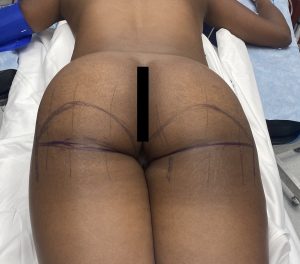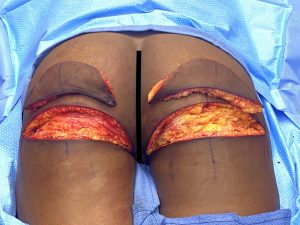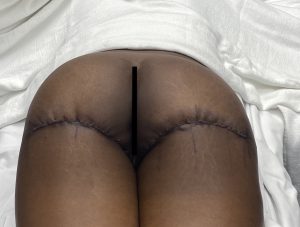Background: The lower extent of the ideal buttock shape should have a well defined line or demarcation between it and the upper thighs. (infragluteal fold) This is very similar to the inframammary fold of the breasts although not quite as pronounced due to the smaller projection of the buttock mound.
There are a variety of aesthetic buttock deformities that occur around the infragluteal fold. One of these is ptosis or sagging of lower buttock tissue over the fold. This is present when a well defined infragluteal crease is present and there is a fold of soft tissue over it. This is sometimes referred to as the banana roll deformity. While ptosis is a more anatomic term and indicates exactly what the problem is, the descriptive term banana roll is associated with a liposuction approach to treatment…which does not work.
One common cause of buttock ptosis is volume loss through fat reduction. Significant weight loss is the most common reason this occurs but another is surgical…reducing the size of the buttocks by liposuction. To no surprise when the buttocks is deflated the overlying skin is not going to completely shrink down around a reduced buttock size. The excess tissue drops and falls over a well defined fold line creating an unsightly overhang.
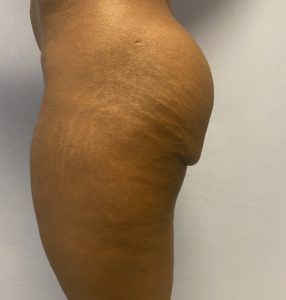
In the standing position right before surgery the infragluteal folds were marked as well as the amount of tissue overhang to be removed.


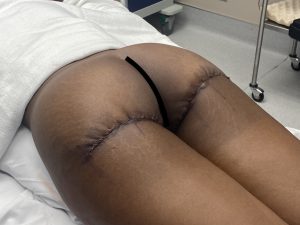
The lower buttock lift is an uncommon procedure buttock reshaping procedure, not because it is not effective, but due to the creation of a scar. There is understandable trepidation on both the patient and the surgeon about it. Depending upon one’s lifestyle and clothes it may or may not be a particularly visible scar. One effective strategy is to limit the horizontal extent of the scar. Do not have it go beyond the natural endpoint of the infragluteal fold laterally even if it means less tissue is excised. The medial end of the incision needs to stay away as best as possible from getting too close to the labia to decrease the risk of scar contracture of an otherwise mobile flexible tissue area.
Case Highlights:
1) Liposuction of the buttocks, either in totality or just at the banana roll area, will result in some degree of tissue overhang at the infragluteal fold.
2) Excision of the infragluteal overhang is the definitive and assorted treatment of lower buttock ptosis.
3) The length of the lower buttock lift excision should ideally not go beyond the natural medial and lateral locations of the fold.




